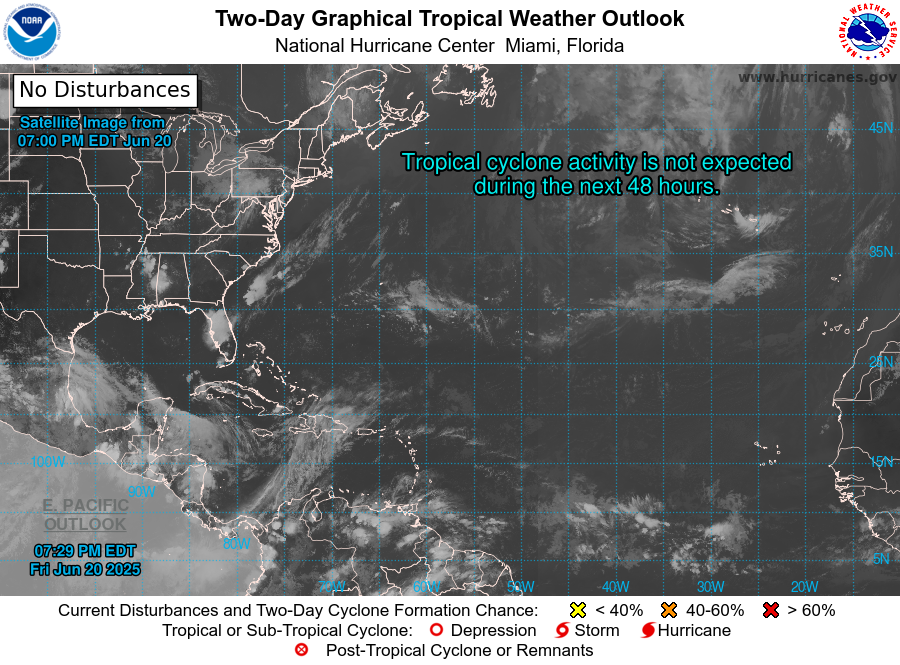Tropical Storm Bret has brough heavy rainfall and high winds to some of the Leeward Islands at the time of writing this post. All the while Tropical Storm Cindy reached tropical storm status overnight . Both storms being present at the same time is unusally for the Main Development Region (MDR) of the Atlantic and we will get into their details in the coming post. For the Eastern Pacific, it appears that we may finally see our first true tropical system form near the Mexican coastline. Looks like both basins are likely to see their Hurricane Season become underway here soon! Let’s work out the details of both below!

Tropical Storm Bret is currently located 5 miles away from St. Vincent and 35 miles away from St. Lucia with winds of 65mph and pressure of 1004 mb. We have tropical storm warnings currently in effect for Dominica, St. Lucia, Martinique, Barbados, St. Vincent, and Grenadines. Some islands are currently experiencing tropical storm conditions and conditions around the islands are expected to improve by midday. Swells will continue to impact the islands until the storm dissipates in a few days.
Bret is expected to maintain tropical storm intensity before weakening into a depression by the end of the weekend. A couple main reasons for this is, while SSTs in the Atlantic Ocean are very warm (at 25°C to 30°C), considerable wind shear aloft between 5,000 ft and 39,000 ft will offer plenty of destructive interference for this storm, as well as very dry air getting ingested in front of the system. Both of these factors will work to weaken Bret over the weekend. The remnants should be monitors as they will continue to bring rainfall to over islands in the near term. Redevelopment of Bret after it dissipates is not expected at this time.

Behind Bret, Tropical Storm Cindy has achieved tropical storm status. Cindy is the third storm of the 2023 year and the the second to develop in the MDR this June. Conditions around the Cindy are expected to remain favorable over the next few days as weak shear, warm SSTs, and moist air provide a sustainable path to intensification.
Tropical Storm Cindy should remain below a hurricane force at this time and for the forecast period and is expected to turn to the north-northwest and avoid the Caribbean. Later in the period, destructive shear near a trough will work to shred the system and turn Tropical Storm Cindy into a shortwave within a larger trough traversing the Atlantic.

Two storms being present in the MDR is common for peak season as the African Wave Train gets underway, but for the month of June its very uncommon. Normally, June is characterized by having high wind shear over the Caribbean, Saharan Dust over the MDR, and fairly weak tropical waves coming off the coast of Africa. This year, the dust is low, the tropical waves are strong, and the MDR is abnormally warm for this time of year. Despite the El Nino pattern providing ample shear, storms have formed in an area that climatological they shouldn’t have yet formed. We shall see if any development happens in July with a similar set of factors appearing to remain in place.
Shifting to the Eastern Pacific, the basin appears to finally be waking up to some activity thanks to some convectively coupled Kelvin waves moving across the region working to provide lift. While development in the next two days isn’t expected over the next week an area of low pressure is expected to develop. The environment around this region will be characterized by low wind shear, warm SSTs, and moist air. Once the system develops it is expected to parallel the Mexico coastline as it moves to the Northwest.

Looking Ahead
The waves behind Cindy in the Atlantic are not expected to form due to an abundance of dry air in the region and high shear in the Caribbean. This should quiet the Atlantic in the near term barring any development closer to the mainland US.
The Eastern Pacific should see a storm or two develop as their season gets underway. With warm SSTs, low wind shear, and abundant moisture its no wonder why the GEFS and other models continue to show a higher likelihood of development across the basin. Interests along the Mexican coastline should monitor the region for development as swells or landfalls could happen with systems that form depending on their path.
Conclusion
As quickly as the Atlantic woke up a slumber looks to be on the horizon which is typical for early season development. We still have several months of hurricane season to go for us in the Atlantic so remaining vigilant and making sure everything is up to date is important! For the East Pacific, a more active pattern appears to be taking shape and activity should be plentiful in the short term. It remains to be seen what impacts the Eastern Pacific systems will have but interests should monitor for high surf and additional impacts as they present themselves.

